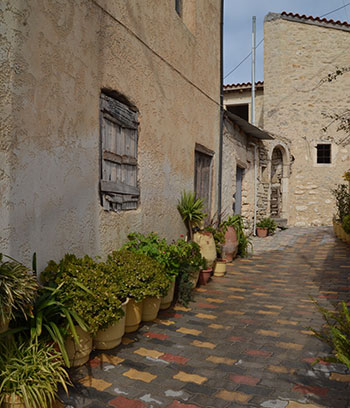 Galifa village is located 25km southeast of the city of Heraklion, built on the top of a hill that is a continuation of the eastern heights "Armeno" and "Kefalopoulo" in the hinterland of the Municipality of Hersonissos. The village offers a view of wild and, at the same time, imposing beauty as it is surrounded by the bald mountains of “Pera Halepa” and “Vigla” in the north,”Kefala” in the east, “Kastello”, “Seira”, “Sgouro”,"Soro (of Pantelis)" and "Toupakis" in the south, while in the west it has a view of Episkopi. The scenery in Galifa is full of low shrubs of sage and thyme and some other shrubs which are characteristic feature of Cretan flora embellishing the whole region.
Galifa village is located 25km southeast of the city of Heraklion, built on the top of a hill that is a continuation of the eastern heights "Armeno" and "Kefalopoulo" in the hinterland of the Municipality of Hersonissos. The village offers a view of wild and, at the same time, imposing beauty as it is surrounded by the bald mountains of “Pera Halepa” and “Vigla” in the north,”Kefala” in the east, “Kastello”, “Seira”, “Sgouro”,"Soro (of Pantelis)" and "Toupakis" in the south, while in the west it has a view of Episkopi. The scenery in Galifa is full of low shrubs of sage and thyme and some other shrubs which are characteristic feature of Cretan flora embellishing the whole region.
A central stone-paved road runs through the village where there are traditional stone-built houses, with whitewashed walls and courtyards with vineyards and flowered pots. South of the village, there is an interesting building of architecture. It is a magnificent stone-built building with tiles that housed the Primary School which had been operated until 1975. The building was restored in 1980 and today, the Cultural Association of Galifa "Seira" is housed in it.
Around the settlement, there are fertile places full of olive groves. Because of its position, Galifa is a place where many waters from the other areas are being gathered, while the Venetian reservoirs still exist in the village at Lake Limni. This area was named after a point in the village where water was collected and formed a lake about 8 meters deep where the inhabitants of the village took water up to 1955. Among the village hill and the surrounding hills, water streams pass and are strengthened by the torrents of "Keratolakos", "Sgouros" and "Turkos", which converge in the Kamara area with the river and continue to the Galifianos river.
The village has been inhabited since the Minoan years according to unofficial archaeological findings in the village and the nearby sanctuaries located at the top of hills, such as in Smari and Episkopi. Pots and clay constructions as well as areas where the grapes or olives were processed have been found during the excavations made. The visitor can visit the communal "wine-press" in the homonymous area that is now the base of the Stavromenos temple.
Galífa is an area with rich history. The visitors worth visiting the temples of different periods, such as the chapel of Agios Dimitrios, which is located in a grove, of Agia Paraskevi-Agios Panteleimonas, a 13th-century monastery with remarkable frescoes and the churches of Agia Marina and Agios Nikitas located in the village.
The largest feast in Galifa is celebrated on the day of the Holy Spirit on 5th of June in the temple of Agia Triada with a feast accompanied by live Cretan music, dance and food.
In addition, residents of Galifa have a special tradition in celebrating their Apokries (Carnival celebration), as each year they organize a successful carnival. The carnival usually takes place in the village on the last Sunday of Apokries and is organized by the Cultural Association with dance and chariots. It is a special and impressive event for visitors and tourists of the village.